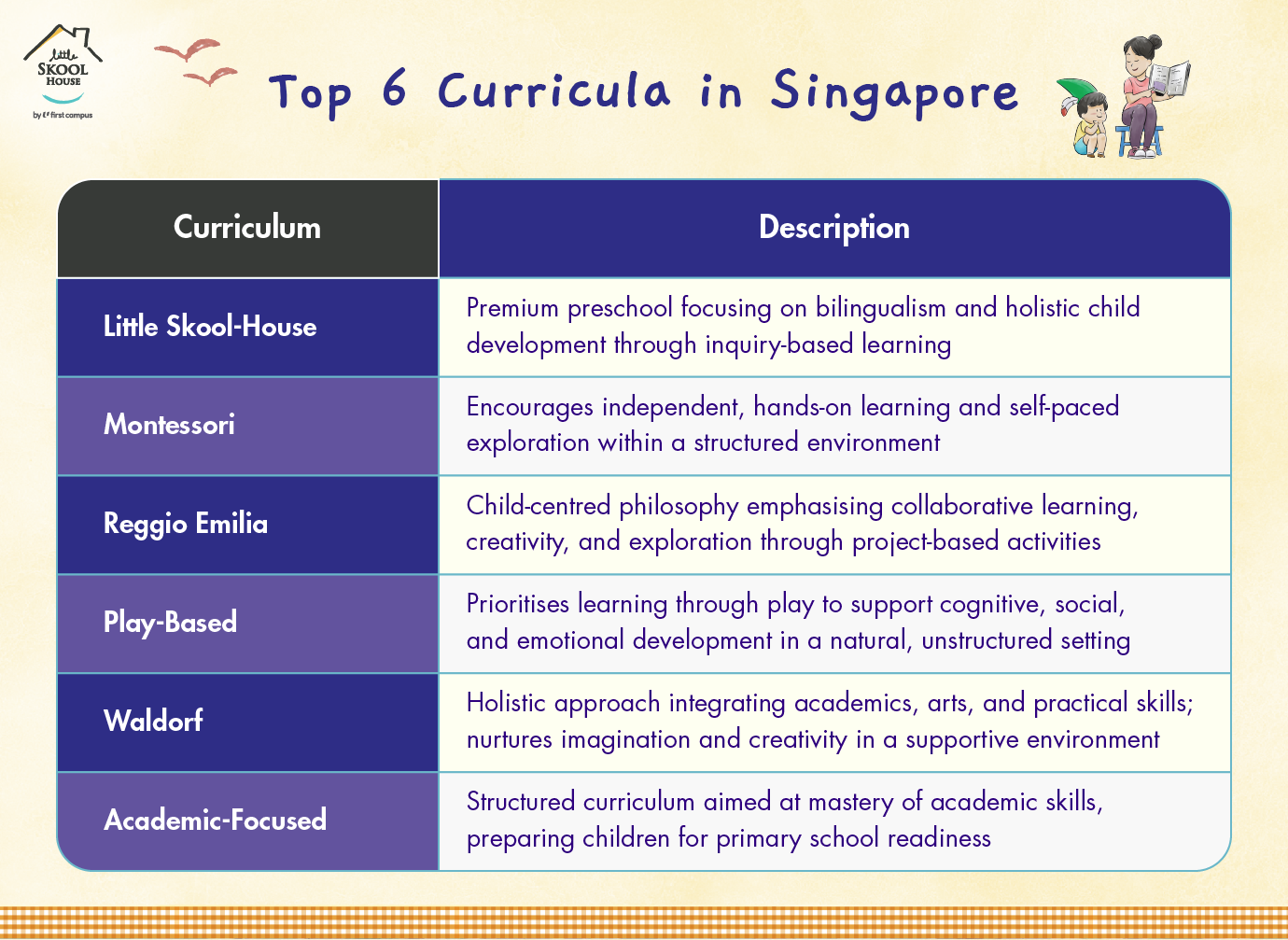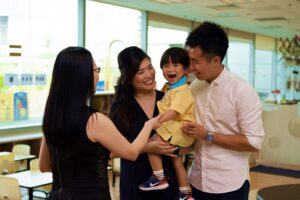BACK
Key Takeaways
- Choosing the right kindergarten curriculum is a pivotal decision for parents in Singapore. The early years of a child’s education lay the foundation for their academic, social, and emotional development.
- With diverse curriculum options — from global frameworks to local programmes — choosing the right path can be overwhelming. Centres like Little Skool-House offer a bilingual, child-centred curriculum that fosters creativity and critical thinking, while aligning with MOE guidelines for a smooth transition to primary school.
- Selecting the best curriculum involves aligning it with the educational vision and learning styles of the institution, as well as ensuring effective implementation and teacher training.
This guide breaks down the most popular kindergarten curricula in Singapore, including our unique approach here at Little Skool-House, helping you make an informed choice.
Why Curriculum Choice in Singapore Matters
Early childhood education is more than just preparing children for primary school; it shapes their approach to learning, social interaction, and problem-solving. Children are naturally curious, and a good curriculum can harness this curiosity to foster a love for learning.
In Singapore, parents often weigh the benefits of various curricula based on factors such as academic focus, play-based learning, cultural relevance, and future readiness. Understanding the differences can help ensure that your child not only excels academically but also thrives socially and emotionally.
Top 6 Curricula in Singapore

Here’s a quick overview of the most popular educational approaches in Singapore—each offering unique learning experiences to support your child’s growth and development.
- Little Skool-House. A premium preschool in Singapore that focuses on bilingualism and holistic child development through inquiry-based learning.
- Montessori. An educational approach that encourages independent, hands-on learning and self-paced exploration in a structured environment.
- Reggio Emilia. A child-centred philosophy that emphasises collaborative learning, creativity, and exploration through project-based activities.
- Play-Based. A curriculum that prioritises learning through play, allowing children to develop cognitive, social, and emotional skills in a natural, unstructured environment.
- Waldorf. A holistic approach that integrates academics, arts, and practical skills, emphasising imagination and creativity in a nurturing environment.
- Academic-Focused. A curriculum centred on structured learning and mastery of academic skills, preparing children for primary school readiness.
Factors to Consider When Choosing a Kindergarten Curriculum
Choosing the right kindergarten curriculum is crucial for shaping your child’s early learning journey. Here are key factors to keep in mind:
- Child’s Learning Style and Temperament. Every child is unique—some thrive in structured settings, while others excel with play-based learning.
- Alignment with Family Values and Goals. Think about what you want your child to gain. For bilingual mastery, Little Skool House is an excellent choice with its focus on English and Mandarin.
- Teacher Quality and Learning Environment. The curriculum is only as good as its implementation. Look for well-trained teachers and learning spaces that reflect the curriculum’s philosophy, whether structured or exploratory.
- Class Size and Student-Teacher Ratio. Smaller class sizes allow for more personalised attention, especially in self-directed learning environments.
- Facilities and Extracurricular Opportunities. A holistic kindergarten experience includes outdoor play and creative projects. Ensure the school’s facilities support these learning methods.
By considering these factors, you can select a curriculum that aligns with your child’s learning style and your family’s values.
Comparison Table of Kindergarten Curricula
| Curriculum | Key Principles | Suitable For |
| Little Skool House | Bilingual foundation, child-centred learning, emphasis on literacy and expressive communication | Parents who value strong language skills and holistic growth |
| Montessori | Self-directed learning, hands-on activities, mixed-age classrooms | Independent learners who thrive on exploration |
| Reggio Emilia | Project-based learning, community involvement, expressive arts | Creative, socially inclined children |
| Play-Based | Learning through play, child-led exploration, social skills development, and creative activities like art projects | Children who learn best through exploration |
| Waldorf | Imagination, sensory experiences, and holistic development | Parents seeking holistic and nature-based learning |
| Academic-Focused | Structured learning, literacy and numeracy focus, assessment-driven | Parents prioritising academic preparedness |
Understanding Different Kindergarten Curricula: Key Principles and Strengths
When it comes to kindergarten education in Singapore, parents have a range of curriculum options to consider. Each approach is designed to cater to different learning styles and developmental goals.
Here’s a breakdown of the main curricula you’ll find across preschools in Singapore.
Little Skool-House Approach
Little Skool-House is renowned for its bilingual approach and emphasis on language mastery for kids from an early age. Our kindergarten curriculum is thoughtfully designed to foster expressive language skills, build confidence, and nurture holistic development.
Key Principles:
- Strong bilingual foundation (English and Mandarin).
- Child-centred learning with a focus on literacy and expressive communication.
- Emphasis on critical thinking and social interaction.
Strengths:
- Language mastery and confidence in both English and Mandarin.
- Development of cognitive and social skills through interactive learning.
- Nurturing confident communicators prepared for primary school.
Montessori Curriculum
The Montessori approach is a well-established educational philosophy that promotes independence and hands-on learning. In a Montessori classroom, children are encouraged to explore and learn at their own pace through self-directed activities.
Key Principles:
- Self-directed learning with teacher guidance.
- Hands-on activities and tactile learning materials.
- Mixed-age classrooms encourage peer learning.
Strengths:
- Encourages independence and self-discipline.
- Develops fine motor skills and problem-solving abilities.
- Promotes curiosity and intrinsic motivation for learning.
Reggio Emilia Curriculum
The Reggio Emilia philosophy is rooted in project-based learning and community involvement. It emphasises the importance of the learning environment as the “third teacher” and encourages exploration through expressive arts.
Key Principles:
- Project-based learning driven by children’s interests.
- Collaboration with parents, teachers, and the community.
- Focus on expressive arts, such as drawing, sculpture, and storytelling.
Strengths:
- Fosters creativity, collaboration, and communication skills.
- Encourages children to express their understanding through various media.
- Promotes a deep sense of community and belonging.
Play-Based Curriculum
Play-based learning is centred on the belief that children learn best through play. This curriculum is child-led, with teachers facilitating learning through exploration and imagination.
Key Principles:
- Learning through unstructured play and exploration.
- Focus on social interaction and emotional regulation.
- Child-led activities with minimal structured instruction.
Strengths:
- Enhances social skills, emotional resilience, and imagination.
- Allows children to develop at their own pace with a focus on joy in learning.
- Particularly effective for developing language and communication skills.
Waldorf Curriculum
Waldorf education is grounded in sensory experiences, imagination, and creative play. It focuses on holistic development, integrating academic, artistic, and practical skills.
Key Principles:
- Emphasis on imagination and creativity.
- Sensory-based learning experiences.
- Holistic development covering mind, body, and spirit.
Strengths:
- Promotes creativity, artistic expression, and hands-on learning.
- Encourages emotional resilience and social cooperation.
- Fosters a strong sense of community and nature appreciation.
Academic-Focused Curriculum
This curriculum is designed with a strong emphasis on literacy, numeracy, and structured learning. It is often more aligned with traditional schooling expectations.
Key Principles:
- Structured learning environment focused on academics.
- Emphasis on literacy, numeracy, and foundational skills.
- Regular assessments to track progress.
Strengths:
- Builds a strong foundation for primary school readiness.
- Clear structure and measurable learning outcomes.
- Familiarises children with school-like routines and expectations.
Global vs. Local Perspectives
When evaluating kindergarten curricula, it’s crucial to understand how these philosophies are adapted in different cultural contexts.
In Singapore, the focus on bilingualism, academic excellence, and holistic development shapes how global educational theories are implemented.
- Little Skool-House curriculum supports bilingual mastery in English and Mandarin, aligning with Singapore’s educational goals and strong focus on expressive language development.
- Montessori schools maintain self-directed learning principles while integrating local MOE guidelines to ensure readiness for primary school.
- Reggio Emilia in Singapore emphasises community involvement and bilingual project work, fostering appreciation for local diversity.
- Play-Based Curriculum remains true to its exploratory nature but incorporates structured activities to prepare children for primary school.
- Waldorf education, though less common, may integrate local storytelling and cultural elements to deepen connections with Singapore’s heritage.
- Academic-Focused Curriculum mirrors Singapore’s structured and assessment-driven approach, aligning with primary school expectations.
Understanding these global and local nuances helps parents select a curriculum that not only suits their child’s learning style but also fits within Singapore’s educational landscape.
How Little Skool-House’s Curriculum Prepares Children for Success
Choosing the right kindergarten curriculum is crucial for setting the foundation for your child’s lifelong learning. Whether you favour the independence of Montessori, the creativity of Reggio Emilia, or the structure of an academic-focused approach, understanding each curriculum’s strengths is key.
In Singapore’s educational landscape, Little Skool-House stands out with its bilingual, child-centred curriculum that balances structured learning and creative exploration. With a focus on literacy, expressive language, and future-ready skills, it prepares children for primary school and beyond.
Ultimately, early education is about more than academics; it’s about nurturing curiosity, empathy, and resilience for lifelong learning.
Little Skool-House is a leader in early childhood education, offering a bilingual curriculum where skills and concepts are taught to prepare children for primary school and beyond.
- Bilingual Mastery and Expressive Language. Children at Little Skool-House learn English and Mandarin fluently, equipping them for Singapore’s multilingual environment.
- Holistic Development Through Child-Centred Learning. The curriculum fosters creativity and confidence through activities like storytelling and group projects.
- Future-Ready Skills for the 21st Century. Little Skool-House nurtures critical thinking and collaboration through project-based learning.
- Experienced Educators and Nurturing Environments. Qualified teachers provide bilingual education in warm, engaging classrooms.
- A Seamless Transition to Primary School. The curriculum aligns with MOE guidelines, ensuring children are well-prepared for primary school.
Choose from 20 Conveniently-Located Centres
Discover the Little Skool-House Difference
Register Now for a Journey of Learning and Growth.
- Award-winning teachers
- Proven bilingual curriculum
- Trusted by parents across Singapore
Limited slots available. Secure your child’s place today.



